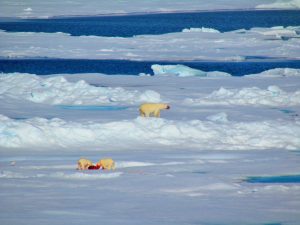E17 – Bonus Clip: Memories of the North

A mama polar bear and her two cubs devouring a seal.
Credit: David Babb.
Check out this clip that didn’t make it into our recent episode, Science Turns to Search and Rescue, about some of the wildlife that’s found in the Arctic.
Episode transcript
Shane Hanlon: And we’re back.
Nanci Bompey: We’re back for a bonus clip, I believe.
Shane Hanlon: Yes, yeah. We get to hear now about all of the fantastic wildlife that is up in the Arctic as an add-on to our most recent episode about an unexpected search and rescue.
David Babb: I’ve never seen a narwhal, unfortunately. I’ve seen lots of belugas, there was a lot of beluga in Hudson Bay this summer.
Lots of seals. I could see the seals out on top of the ice, where they haul out of their layers. Some of them, as soon as the ship shows up, or as soon as a helicopter shows off, they kind of skittishly wiggle their way off the edge of the ice and get into the water and disappear. And others just look at the ship go by like they couldn’t give a care in the world. They just watch this big red ship go by, making all this noise, breaking the ice, and the seals are just chilling on the ice watching as you go by.
In northern Canada and in Greenland I’ve seen a lot of muskox. These big kind of buffalo-looking creatures, big horns at the front, they’re quite hairy. So we’ve seen lots of those.
And, fortunately, every time I’ve seen a polar bear, I’ve either been in a helicopter or I’ve been on a ship. So I’ve never personally seen a bear while I’ve had my own two feet on the ice. But in saying that, I mean, we always have guns with us, and we always have flares and bear bangers, and-
Lauren Lipuma: What’s a bear banger?
David Babb: A bear banger is a little thing you can carry in your pocket that shoots off a really loud sounding firecracker, basically. So, yeah, you’re always prepared for it, but, fortunately, we’ve never had to deal with a bear. I feel like, yeah, if you ever came face to face with a polar bear, I don’t think you would fare very well, so we’re very, very careful about that.
Lauren Lipuma: What’s it like to see them, though, from afar?
David Babb: It’s amazing. They’re beautiful, they’re huge, but you can be out in the middle of nowhere, under extreme conditions, extreme cold and wind, and then all of the sudden, you see a bear go by, and you think, “How is this animal able to persist through this harsh environment?” But they are, and they’re beautiful, they’re huge-
Lauren Lipuma: What are they usually doing when you see them? Are they just kind of hanging out? Or…
David Babb: A lot of walking. They usually run away from the ship, especially if it’s a mom with cubs, they usually want nothing to do with the ship or the helicopter. A couple years ago though, the ship came into an ice area and there was a mom and two cubs and she had just pulled out a seal onto the ice, and they were eating the seal.
And, I mean, one of the most beautiful things about polar bears is their coat. It’s this pure white, just beautiful. I’ve been in a couple communities when they’re skinning the bears and dealing with the furs, and the coat is beautiful, it’s so thick and heavy and you really understand how they can stay so warm while they’re out there.
But this mom and two cubs in the Beaufort Sea were just going to town on this seal, and their red coat… their coat had been covered in red, and they were… I mean, it was totally primal, and they were going to town. It was cool to see.
Lauren Lipuma: Yeah, what did they do when you guys started approaching?
David Babb: They just kept eating. The mom would occasionally kind of look over to see, but the two little cubs, who couldn’t have been much bigger than kind of a medium sized dog, were just going to town on this seal. It was a really cool experience.
Shane Hanlon: All right, well that’s all. Be sure to check out the full episode, that should be earlier on in your feed.
